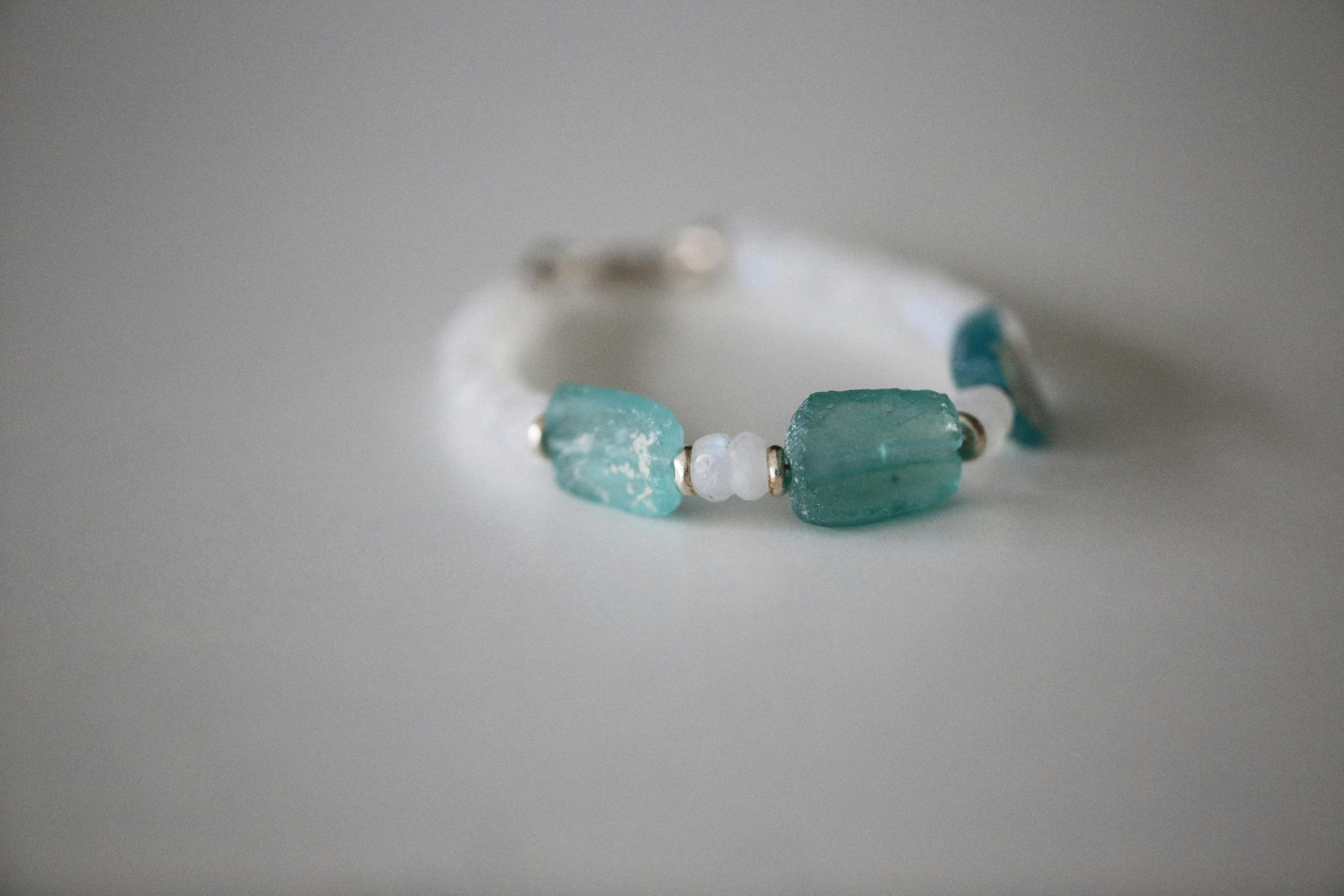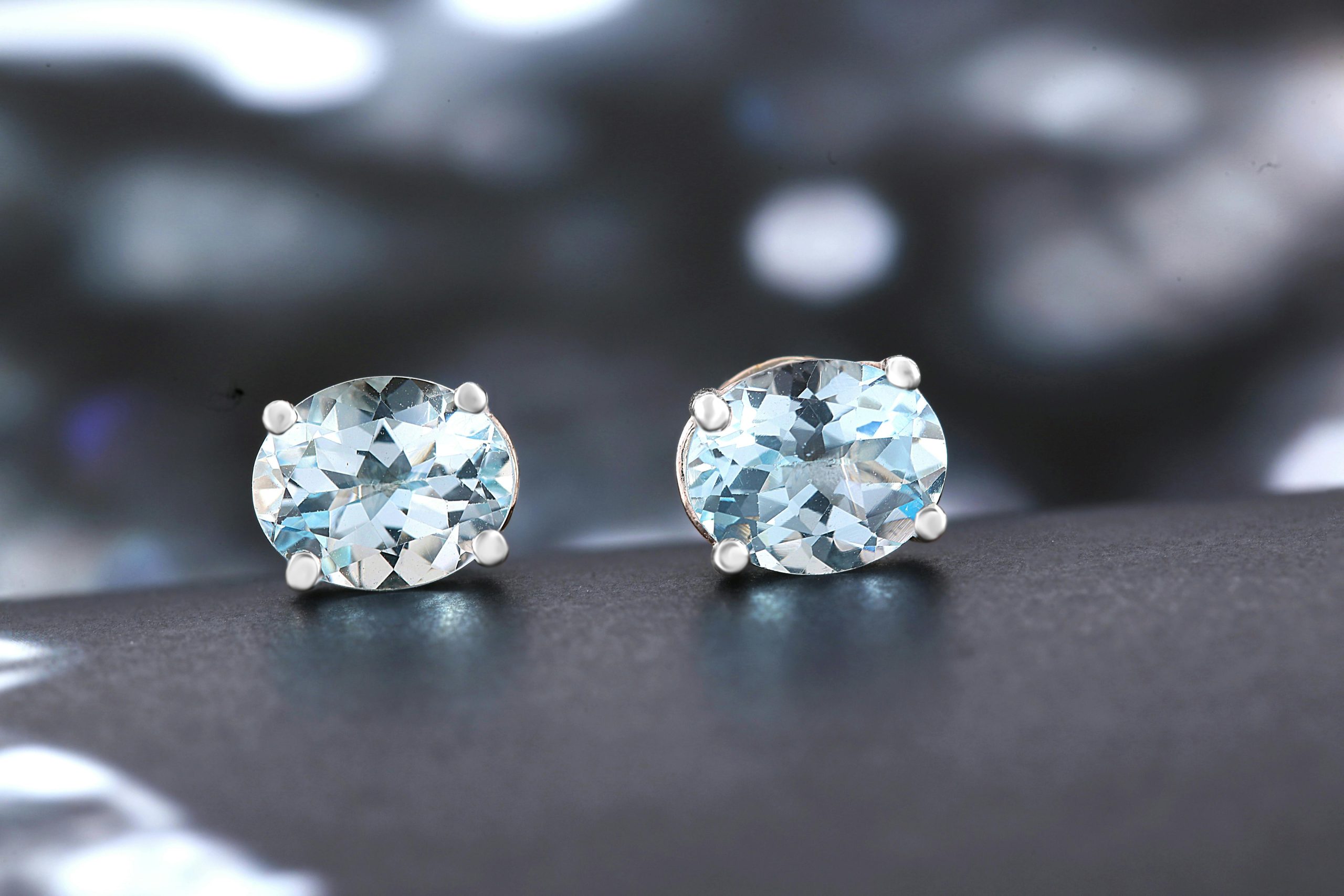If you were born in March, you’re lucky enough to claim the breathtaking aquamarine as your birthstone. With its tranquil blue hues reminiscent of clear ocean waters, the aquamarine has captivated people for thousands of years. In this article, we’ll explore the fascinating world of this March birthstone – from its rich history and formation to its color psychology and symbolic meanings.
What is Aquamarine?
Aquamarine belongs to the beryl family of minerals, making it a cousin to other popular gemstones like emerald and morganite. Its name comes from the Latin words “aqua” (water) and “marina” (of the sea), perfectly describing its seawater-like color. Aquamarine ranges from pale sky blue to deeper blue-green shades, with the most valued specimens displaying a pure, intense blue.
While aquamarine is the primary March birthstone in modern birthstone lists, it shares this honor with bloodstone, an alternative March gemstone. Bloodstone, a type of cryptocrystalline quartz, offers a dramatically different appearance with its dark green body and distinctive red spots.
The Natural Formation of Aquamarine
Aquamarine forms in granite rocks, often appearing as six-sided prismatic crystals that can grow to impressive sizes. Unlike many gemstones that typically form as small pebbles, aquamarine crystals can reach remarkable dimensions – some weighing over 100 pounds have been discovered!
Brazil stands as the world’s largest producer of aquamarine, with significant deposits also found in countries like Nigeria, Madagascar, Zambia, Pakistan, and Mozambique. Brazilian aquamarines are particularly prized for their exceptional clarity and color saturation.
The Color Psychology of Aquamarine
The soothing blue of aquamarine carries powerful psychological effects. Color psychologists note that this shade of blue:
- Promotes calmness and reduces stress
- Encourages clear communication
- Enhances mental clarity and focus
- Creates feelings of peace and tranquility
- Inspires trust and openness
These effects align perfectly with aquamarine’s traditional associations with serenity and clear thinking. People drawn to aquamarine often value emotional balance and straightforward communication in their lives.
Aquamarine Through History
Aquamarine has a rich historical legacy spanning thousands of years:
Ancient Times
In ancient times, aquamarine was deeply connected to water and sea travel. Sailors carried aquamarine as a talisman for safe voyages, believing it would calm the waves and protect them from drowning. The stone was thought to be the treasure of mermaids, with some legends claiming the gems had fallen from their jewelry boxes.
The ancient Romans prized aquamarine for both its beauty and healing properties. They believed it could cure ailments of the stomach, liver, and throat. Roman physicians would immerse aquamarine in water and give this “charged” water to patients, believing the stone’s essence would transfer healing powers to the liquid.
Middle Ages to Renaissance
During the Middle Ages, fortune tellers and mystics used aquamarine as a crystal ball, believing its clear blue depths perfect for revealing visions of the future. European royalty sought aquamarine not just for its beauty but for its supposed power to rekindle love between married couples.
Renaissance-era physicians continued to use aquamarine for medicinal purposes, especially for eye conditions. They would place the cool stone on closed eyelids to reduce inflammation and improve eyesight.
Modern Era
In more recent history, aquamarine received significant attention when First Lady Eleanor Roosevelt received a stunning 1,298-carat aquamarine from the Brazilian government – the largest ever gifted to an American First Lady. This remarkable gift highlighted diplomatic relations and brought new popularity to the gemstone in the United States.
Today, aquamarine remains a favorite among jewelry designers for its durability (7.5-8 on the Mohs hardness scale), beautiful color, and excellent clarity. While it doesn’t command the premium prices of sapphire or ruby, fine aquamarine specimens with deep blues can be quite valuable.
Symbolism and Meaning
Aquamarine carries rich symbolic meanings across various traditions:
Good Fortune and Protection
As the “treasure of mermaids,” aquamarine was believed to bring good luck to anyone who possessed it. Sailors kept it as protection during voyages, believing it would safeguard them from the sea’s dangers. This protective quality extends to modern interpretations, where aquamarine is still considered a powerful talisman for travelers.
Clarity and Truth
The transparent blue of aquamarine symbolizes honest communication and clear thinking. In ancient Rome, couples used aquamarine to resolve conflicts, believing it helped reveal the truth and foster understanding. Today, aquamarine is still associated with clear communication, making it a thoughtful gift for resolving misunderstandings or strengthening relationships.
Eternal Youth and Happiness
Many cultures connect aquamarine with youthfulness and joy. The Romans believed wearing aquamarine would keep the body young and the spirit happy. This association with youthful energy and contentment continues in modern interpretations of the stone’s meaning.
Zodiac Connections
Aquamarine holds special significance for those born under Pisces (February 19-March 20) and Aries (March 21-April 19) zodiac signs. For Pisces, the water-connected stone enhances their natural intuition and emotional depth. For Aries, aquamarine is thought to temper their fiery nature with calming energies.
Aquamarine Jewelry and Care
Aquamarine’s durability makes it suitable for various jewelry types:
Popular Styles
Aquamarine appears in diverse jewelry forms:
- Necklaces: Often showcasing larger stones to highlight the color
- Engagement rings: A popular alternative to diamonds, especially for March birthdays
- Earrings: The sparkle of aquamarine catches light beautifully near the face
- Bracelets: Often combined with diamonds or pearls for elegant contrast
Historical Designs
Throughout history, aquamarine has been featured in significant jewelry pieces:
- Roman seals and amulets: Often engraved with protective symbols
- Victorian tiaras: Featuring large aquamarines as centerpieces
- Art Deco designs: Combining aquamarine with diamonds in geometric patterns
Caring for Aquamarine
While durable, aquamarine requires proper care:
- Clean with warm water and mild soap using a soft brush
- Avoid steam cleaning or ultrasonic cleaners
- Store separately from harder gemstones like diamonds to prevent scratching
- Remove before using household chemicals or during rough activities
Choosing the Perfect Aquamarine
When selecting aquamarine jewelry, consider these factors:
Color Quality
The most valued aquamarines display a pure, medium-dark blue without gray overtones. While many aquamarines naturally have a slight greenish tint, the most prized specimens show pure blue similar to fine sapphires.
Clarity and Cut
Unlike emerald (its beryl cousin), aquamarine typically forms with excellent clarity. Expect good quality stones to be eye-clean with no visible inclusions. The cut should maximize the stone’s color while creating bright sparkle.
Size and Value
Aquamarine’s relative abundance means larger stones remain reasonably affordable compared to other precious gemstones. This makes aquamarine an excellent choice for statement pieces featuring sizeable center stones.
Modern Interpretations and Popularity
Today, aquamarine continues to captivate jewelry lovers for several reasons:
- Its soothing blue color aligns with contemporary color preferences
- The connection to water and nature resonates with environmentally-conscious consumers
- Its relative affordability compared to sapphires makes it accessible
- Its durability ensures long-lasting beauty
As a March birthstone, aquamarine makes a meaningful gift that connects the recipient to centuries of tradition while providing a gemstone of enduring beauty and symbolism.
Conclusion
Whether you’re drawn to aquamarine for its birthday connection, its calming blue color, or its rich historical significance, this gemstone offers a beautiful combination of accessibility and luxury. From the treasure of mermaids to the gift of Brazilian diplomacy, aquamarine continues to enchant with its ocean-blue depths and crystal clarity.
For those born in March, wearing aquamarine connects you to a legacy of clear communication, protection, and tranquility – a fitting tribute to a month that bridges winter and spring, bringing clarity after the fog of winter and promising the renewal of warmer days ahead.


